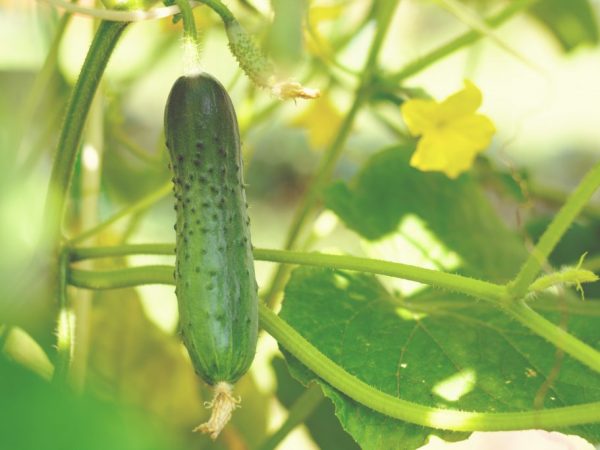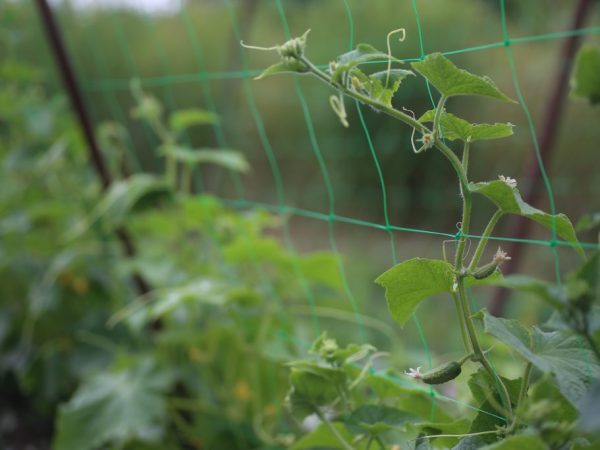Characteristics of the Vyatsky cucumber variety
The hybrid origin endows vegetable crops with a number of positive qualities. Cucumber Vyatsky F1 was bred for planting in unfavorable conditions.

Characteristics of Vyatsky cucumbers
This hybrid has high resistance to many diseases and is unpretentious in care. They also note the pleasant taste and early maturity of the fruit.
Species characteristics
The Vyatsky variety has a number of features:
- The fruit is suitable for salads, but the variety is not suitable for canning.
- Ripening lasts 1 month, the species is classified as early maturing.
- The yield from 1 bush reaches 12 kg.
The culture is suitable for both open and closed cultivation, but most often cucumbers are planted using seedlings. It is also recommended to use trellises when planting: this makes it easier to care for plants and increases the yield of bushes.
Cucumbers tolerate adverse conditions well, they are grown in almost any region of the temperate climatic zone.
Description of the bush
The weaving of the variety belongs to the middle type, the ovaries have a bundle shape. Lateral shoots form quickly.
The type of flowering is female; in the leaf axils, the number of female flowers varies from 1 to 3.
Description of fruits
Cucumbers of this variety have certain standards:
- cucumber length - 12 cm;
- diameter - 4 cm;
- average weight - 130 g.
There are no voids and bitterness in the pulp, the fruits are cylindrical in shape. The surface is moderately lumpy, with small white spines. Cucumbers have a delicate texture and a well-pronounced taste. The long keeping quality and strength of the fruits allows them to withstand long-term transportation.
Culture care
F1 hybrids are unpretentious, but good conditions should be provided for high yields. Cucumbers require:
- weeding;
- watering;
- top dressing.
Watering
The watering regime depends on the stage of plant growth. Before the formation of ovaries for 1 sq. m make 5 liters of water in the absence of rain and 3 liters during precipitation. During the ripening period, cucumbers require more liquid, so the water rate is increased to 10 liters in dry weather and 6 liters after rain.
Hilling

The plant does not tolerate hypothermia
According to the description, Vyatka cucumbers do not tolerate the hardening of the upper soil layer poorly. After irrigation, the bushes are spud. At the same time, it is taken into account that the roots of the plant are close to the surface, so you should act carefully. Also, this species does not tolerate hypothermia, so it should be watered in the early hours with room water.
Fertilizers
Nitrogen and sulfate fertilizers can be used as fertilizer. There are also mineral complexes that can be prepared at home:
- infusion on onion peel - 200 g of leaves per 5 liters of water;
- serum solution with the addition of iodine - 1 liter of serum, 15 drops of iodine per 10 liters of water;
- mullein or chicken droppings diluted in water - 500 g of organic matter per 10 liters of water.
Some farmers recommend adding organic matter directly while watering. To do this, 10 g of urea is diluted in 10 liters of water.
Formation
For any type of cultivation, cucumber whips need to be shaped. Excess shoots can cause low yields and fruit deformation due to uneven distribution of sunlight. During the period of intensive growth (when 9-10 full-fledged leaves are formed on the main stem), 2 lower lateral lashes are removed. They also monitor how the main stem develops: when the lash reaches the top of the trellis, growth is stopped by pinching 2-3 top leaves.
Side lashes are cut during the growing season, but it is important to maintain the integrity of the main stem and the initial side shoots.
Diseases and pests
The hybrid origin gives the seeds of this species immunity to many fungal and bacterial diseases, however, timely prevention helps to minimize the risk of disease.
The early maturity of the variety does not allow spraying shoots with potent agrochemicals, as this leads to toxicity of the fruit. Plants are treated with solutions prepared independently:
- A mixture of iodine and milk with the addition of soap is used against powdery mildew. The solution is used to treat the foliage of plants.
- Gray rot of the roots or stem recedes before watering with water from 1 tbsp. l. baking soda.
- Bacteriosis is prevented with 2 tablets of Trichopolum, which are diluted in 1 liter of water.
Harmful insects pose a greater threat to cucumbers than diseases. Among them, whiteflies and aphids are especially dangerous. To get rid of pests, the soil is dug to a depth of 20 cm. Frost will destroy the weed larvae and seeds.
Also, garlic or onions are planted between the rows: insects cannot stand the smell of these vegetables. Dill is also distinguished among natural pest control agents.
Immediately before planting, it is recommended to calcine the seeds and treat them with special nutrients: this will reduce the risk of disease and increase yields.
Conclusion
Cucumber Vyatsky F1 belongs to a series of self-pollinating hybrids. The variety is resistant to most diseases and easy to care for. The fruits have a marketable appearance and high taste.


